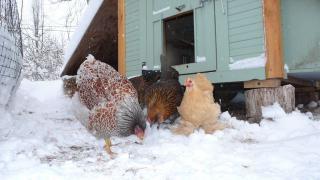You all will have to forgive me at times. I'm a purist and I'm also pretty emotional (yeah, I cried for Titanic! But I never gave up!!). Occasionally, I step over a line or two. So, as Jesse said, lets look at this from the point of view of learning not making dumb comments like I just did about rocks (which, if you couldn't tell, I detest).
As a purist, I'm also very interested in the welfare of poultry and its genetic base as a whole. History is repeated by those who don't learn from it. Events like the small pox epidemic, potato famine and, more recently, the wide-spread panic over such diseases as swine flu, avian influenza, Exotic Newcastle, etc. are greatly exacerbated by genetic bases that are unable to deal with stress because of lack of genetic diversity. The commercial poultry industry is distinctly prone to such a problem. The reason is because the birds are so closely related and closely housed that a serious threat can be posed by almost any pathogen. If it can attack one birds' systems, the next bird is probably a cousin.
A breed is not just an outward appearance, even if that appearance matches the Standard of Perfection. The SOP can't measure the purity of a breed's blood and it has never tried. A breed is developed over time, usually in a certain region, and develops genetic characteristics based on the environmental stress in that region. So, as an example, game fowl such as the Asil or Shamo generally don't do well in Northern climates. That isn't where they were developed. (Thankfully for those of us who like chicken, their crosses developed into Cornish, which when crossed with Stones, errrr....rocks, became the basis for all commercial meat flocks.) The Wyandotte was developed in Northern climates as well. The outward colors of a chicken do not determine very many of its overall characteristics. Some that would be important are: disease and parasite resistance, growth rate, feed conversion, ability to digest certain insects or resist certain semi-harmful plants, even a certain quality or flavor of meat, etc.
As breeders, part of our responsibility is to preserve the genetic make-up in the breeds we raise. We can crossbreed and have quicker results. Those results might even win more prizes or look better. But when we do so, we are not maintaining that genetic make-up and we are likely losing a large portion of genetic diversity with each cross. Occasionally, an out-cross might be a necessity (I would say that this is the case in near extinct breeds that have few varieties). Unfortunately, most people who show, myself included, are very likely to lose sight of this because we are focusing on a selfish goal: winning a show. At all costs, we want to win and this causes us to take short-cuts. A rock is the most likely culprit today. Probably because rocks win and judges pick birds that look like rocks. Give a Wyandotte some fluff, put a little leg under her, add a nice, fat rock tail and walk right to the front of the class.
(on an aside: Jesse, you mentioned that rocks have great tails. Fine. They have huge tails, enormous tails. Agreed. Have you ever read what the SOP says a rock tail should look like? I quote "moderately well-spread." Show me a champion rock that you couldn't put your whole head under the tail and I would be surprised. rocks of today are a far cry from what they should be and what they were. Feather quality? I haven't looked at this recently in my SOP, but I'm pretty sure it says hard or moderately hard feathered. There are rocks with more fluff and stuff than lots of Cochins. Something to behold, agreed. A huge chicken that has almost no semblance to its predecessors. I hope they at least still taste good.)
While a variety cross takes more time and effort, it does a much better job of holding together the framework beneath the framework that makes a Wyandotte a Wyandotte and a rock little more than a pile of volcanic ash.
You also mentioned that a color cross will take so long. A cross of a Partridge male and Silver Pencilled females should give Silver hens in the first generation. They are very showable (at least as much as any other Partridge or Silver Pencilled) and they are all Wyandotte. When I show a Wyandotte and put my name on the coop tag, I prefer to put a Wyandotte in the coop, not half a Wyandotte with yellow skin, yellow legs, and carrying a gene for single comb and half the genes of something very un-Wyandotte. Also, the third generation is 87.5% and fourth generation is only 93.75% Wyandotte, of course that is assuming you go back to pure Wyandottes and don't decide the F2 or F3s are better, which is what almost always happens.






